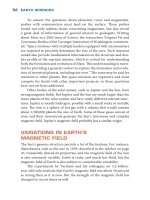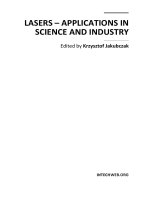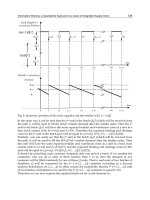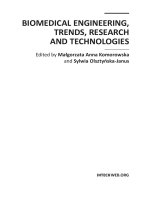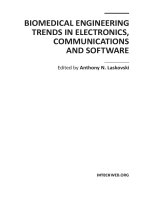EARTH SCIENCES - Notable Research and Discoveries Part 1 ppt
Bạn đang xem bản rút gọn của tài liệu. Xem và tải ngay bản đầy đủ của tài liệu tại đây (562.08 KB, 24 trang )
EARTH
SCIENCES
FOS_Earth Science_DC.indd 1 2/8/10 10:56:01 AM
FOS_Earth Science_DC.indd 2 2/8/10 10:56:02 AM
KYLE KIRKLAND, PH.D.
Notable Research and Discoveries
EARTH
SCIENCES
FOS_Earth Science_DC.indd 3 2/8/10 10:56:14 AM
EARTH SCIENCES: Notable Research and Discoveries
Copyright © 2010 by Kyle Kirkland, Ph.D.
All rights reserved. No part of this book may be reproduced or utilized in any form or by
any means, electronic or mechanical, including photocopying, recording, or by any infor-
mation storage or retrieval systems, without permission in writing from the publisher. For
information contact:
Facts On File, Inc.
An imprint of Infobase Publishing
132 West 31st Street
New York NY 10001
Library of Congress Cataloging-in-Publication Data
Kirkland, Kyle.
Earth sciences: notable research and discoveries / Kyle Kirkland.
p. cm.—(Frontiers of science)
Includes bibliographical references and index.
ISBN 978-0-8160-7442-6 (hardcover)
ISBN 978-1-4381-2968-6 (e-book)
1. Geology. 2. Earth sciences. I. Title
QE501.K527 2010
550—dc22 2009020269
Facts On File books are available at special discounts when purchased in bulk quantities
for businesses, associations, institutions, or sales promotions. Please call our Special Sales
Department in New York at (212) 967-8800 or (800) 322-8755.
You can nd Facts On File on the World Wide Web at tson le.com
Excerpts included herewith have been reprinted by permission of the copyright holders;
the author has made every e ort to contact copyright holders. e publishers will be glad
to rectify, in future editions, any errors or omissions brought to their notice.
Text design by Kerry Casey
Illustrations by Sholto Ainslie and Dale Williams
Photo research by Tobi Zausner, Ph.D.
Composition by Mary Susan Ryan-Flynn
Cover printed by Bang Printing, Inc., Brainerd, Minn.
Book printed and bound by Bang Printing, Inc., Brainerd, Minn.
Date printed: March 2010
Printed in the United States of America
10 9 8 7 6 5 4 3 2 1
is book is printed on acid-free paper.
CONTENTS
Preface ix
Acknowledgments xiii
Introduction xv
1 Exploring Earth’s Depths 1
Introduction 2
Seismic Waves 5
United States Geological Survey (USGS) 10
Inside the Planet 10
Drilling into Earth 15
Heat of Earth’s Interior 17
Project Mohole—An Ambitious Attempt
to Reach Earth’s Mantle 18
Tectonic Plate Movement 21
Dynamics and Interactions of Earth’s Interior 23
Charting the Depths with Research
in the Laboratory 25
Conclusion 27
Chronology 29
Further Resources 31
2 Origin and Variability of
Earth’s Magnetic Field 34
Introduction 35
Earth’s Magnetic Field 39
Geological Survey of Canada 40
FOS_Earth Science_DC.indd 5 2/8/10 10:56:15 AM
Magnetosphere 43
Northern and Southern Lights 44
Dynamo Theory of Earth’s Magnetic Field 47
Magnetic Fields of Other Bodies
in the Solar System 50
Variations in Earth’s Magnetic Field 52
Mid-Ocean Ridges 55
Pole Reversals 56
Conclusion 59
Chronology 61
Further Resources 62
3 Volcanoes and Hot Spots 66
Introduction 67
Ring of Fire 73
Hot Spots 75
Hawaiian Volcano Observatory 78
Plume Hypothesis 82
Plumes and Superplumes 84
Alternative Hypotheses to Explain Hot Spots 86
Conclusion 89
Chronology 92
Further Resources 94
4 Geothermal Energy—
a Furnace beneath the Soil 98
Introduction 100
Exploiting Geothermal Energy 102
Turning Geothermal Energy into Electricity 104
Energy and Economics 107
Geothermal Drilling 109
Geothermal Heat Pumps 112
Geothermal Potential and Capacity 114
Interdisciplinary Science—Many Specialties,
One Goal 116
FOS_Earth Science_DC.indd 6 2/8/10 10:56:15 AM
Enhanced Geothermal Systems 119
Conclusion 122
Chronology 123
Further Resources 125
5 Water Management—Conserving an
Essential Resource 128
Introduction 130
The Water Cycle 133
Aquifers—Underground Water Sources 136
Finding and Using Freshwater 139
The Dust Bowl of the 1930s 140
Hydrologic Modeling and Prediction 144
National Integrated Drought
Information System (NIDIS) 146
Climate Change and Water 148
Conclusion 151
Chronology 153
Further Resources 154
6 Predicting Earthquakes 158
Introduction 160
Richter Scale—an Early Method of
Quantifying Earthquake Intensity 164
Fault Zones 165
San Andreas Fault 168
Warning Systems 171
Watchdogs: Animal Behavior
Preceding an Earthquake 173
Signs of an Impending Earthquake 175
Earthquake Forecasts and Probabilities 177
Predictions and Consequences 178
Strain Accumulation and Surface Deformation 181
San Andreas Fault Observatory at Depth (SAFOD) 182
Conclusion 184
FOS_Earth Science_DC.indd 7 2/8/10 10:56:15 AM
ix
Chronology 186
Further Resources 188
Final Thoughts 192
Glossary 196
Further Resources 200
Index 205
FOS_Earth Science_DC.indd 8 2/8/10 10:56:15 AM
ix
PREFACE
Discovering what lies behind a hill or beyond a neighborhood can be as
simple as taking a short walk. But curiosity and the urge to make new dis-
coveries usually require people to undertake journeys much more adven-
turesome than a short walk, and scientists o en study realms far removed
from everyday observation—sometimes even beyond the present means
of travel or vision. Polish astronomer Nicolaus Copernicus’s (1473–1543)
heliocentric (Sun-centered) model of the solar system, published in 1543,
ushered in the modern age of astronomy more than 400 years before the
rst rocket escaped Earth’s gravity. Scientists today probe the tiny domain
of atoms, pilot submersibles into marine trenches far beneath the waves,
and analyze processes occurring deep within stars.
Many of the newest areas of scienti c research involve objects or places
that are not easily accessible, if at all. ese objects may be trillions of miles
away, such as the newly discovered planetary systems, or they may be as
close as inside a person’s head; the brain, a delicate organ encased and pro-
tected by the skull, has frustrated many of the best e orts of biologists until
recently. e subject of interest may not be at a vast distance or concealed
by a protective covering, but instead it may be removed in terms of time.
For example, people need to learn about the evolution of Earth’s weather
and climate in order to understand the changes taking place today, yet no
one can revisit the past.
Frontiers of Science is an eight-volume set that explores topics at the
forefront of research in the following sciences:
biological sciences
chemistry
•
•
FOS_Earth Science_DC.indd 9 2/8/10 10:56:17 AM
earth ScienceS
x
computer science
Earth science
marine science
physics
space and astronomy
weather and climate
e set focuses on the methods and imagination of people who are
pushing the boundaries of science by investigating subjects that are not
readily observable or are otherwise cloaked in mystery. Each volume
includes six topics, one per chapter, and each chapter has the same for
-
mat and structure. e chapter provides a chronology of the topic and
establishes its scientic and social relevance, discusses the critical ques
-
tions and the research techniques designed to answer these questions,
describes what scientists have learned and may learn in the future, high
-
lights the technological applications of this knowledge, and makes rec-
ommendations for further reading. e topics cover a broad spectrum
of the science, from issues that are making headlines to ones that are
not as yet well known. Each chapter can be read independently; some
overlap among chapters of the same volume is unavoidable, so a small
amount of repetition is necessary for each chapter to stand alone. But
the repetition is minimal, and cross-references are used as appropriate.
Scientic inquiry demands a number of skills. e National Com
-
mittee on Science Education Standards and Assessment and the Na-
tional Research
Council, in addition to other organizations such as the
National Science Teachers Association, have stressed the training and
development of these skills. Science students must learn how to raise
important questions, design the tools or experiments necessary to an
-
swer these questions, apply models in explaining the results and revise
the model as needed, be alert to alternative explanations, and construct
and analyze arguments for and against competing models.
Progress in science oen involves deciding which competing theo
-
ry, model, or viewpoint provides the best explanation. For example, a
major issue in biology for many decades was determining if the brain
functions as a whole (the holistic model) or if parts of the brain carry out
specialized functions (functional localization). Recent developments in
brain imaging resolved part of this issue in favor of functional localiza
-
tion by showing that specic regions of the brain are more active during
•
•
•
•
•
•
FOS_Earth Science_DC.indd 10 2/8/10 10:56:17 AM
xi
certain tasks. At the same time, however, these experiments have raised
other questions that future research must answer.
e logic and precision of science are elegant, but applying scientic
skills can be daunting at rst. e goals of the Frontiers of Science set are
to explain how scientists tackle dicult research issues and to describe re
-
cent advances made in these elds. Understanding the science behind the
advances is critical because sometimes new knowledge and theories seem
unbelievable until the underlying methods become clear. Consider the
following examples. Some scientists have claimed that the last few years
are the warmest in the past 500 or even 1,000 years, but reliable tempera
-
ture records date only from about 1850. Geologists talk of volcano hot
spots and plumes of abnormally hot rock rising through deep channels,
although no one has drilled more than a few miles below the surface.
Teams of neuroscientists—scientists who study the brain—display im
-
ages of the activity of the brain as a person dreams, yet the subject’s skull
has not been breached. Scientists oen debate the validity of new experi
-
ments and theories, and a proper evaluation requires an understanding
of the reasoning and technology that support or refute the
arguments.
Curiosity about how scientists came to know what they do—and
why they are convinced that their beliefs are true—has always motivat
-
ed me to study not just the facts and theories but also the reasons why
these are true (or at least believed). I could never accept unsupported
statements or conne my attention to one scientic discipline. When
I was young, I learned many things from my father, a physicist who
specialized in engineering mechanics, and my mother, a mathematician
and computer systems analyst. And from an archaeologist who lived
down the street, I learned one of the reasons why people believe Earth
has evolved and changed—he took me to a eld where we found ma
-
rine fossils such as shark’s teeth, which backed his claim that this area
had once been under water! Aer studying electronics while I was in
the air force, I attended college, switching my major a number of times
until becoming captivated with a subject that was itself a melding of
two disciplines—biological psychology. I went on to earn a doctorate in
neuroscience, studying under physicists, computer scientists, chemists,
anatomists, geneticists, physiologists, and mathematicians. My broad
interests and background have served me well as a science writer, giving
me
the condence, or perhaps I should say chutzpah, to write a set of
books on such a vast array of topics.
Preface
FOS_Earth Science_DC.indd 11 2/8/10 10:56:18 AM
EARTH SCIENCES
xii
xiii
Seekers of knowledge satisfy their curiosity about how the world
and its organisms work, but the applications of science are not limited
to intellectual achievement. e topics in Frontiers of Science a ect so-
ciety on a multitude of levels. Civilization has always faced an uphill bat-
tle to procure scarce resources, solve technical problems, and maintain
order. In modern times, one of the most important resources is energy,
and the physics of fusion potentially o ers a nearly boundless supply.
Technology makes life easier and solves many of today’s problems, and
nanotechnology may extend the range of devices into extremely small
sizes. Protecting one’s personal information in transactions conducted
via the Internet is a crucial application of computer science.
But the scope of science today is so vast that no set of eight vol-
umes can hope to cover all of the frontiers. e chapters in Frontiers
of Science span a broad range of each science but could not possibly be
exhaustive. Selectivity was painful (and editorially enforced) but nec-
essary, and in my opinion, the choices are diverse and re ect current
trends. e same is true for the subjects within each chapter—a lot of
fascinating research did not get mentioned, not because it is unimport-
ant, but because there was no room to do it justice.
Extending the limits of knowledge relies on basic science skills as
well as ingenuity in asking and answering the right questions. e 48
topics discussed in these books are not straightforward laboratory exer-
cises but complex, gritty research problems at the frontiers of science.
Exploring uncharted territory presents exceptional challenges but also
o ers equally impressive rewards, whether the motivation is to solve a
practical problem or to gain a better understanding of human nature. If
this set encourages some of its readers to plunge into a scienti c frontier
and conquer a few of its unknowns, the books will be worth all the e ort
required to produce them.
FOS_Earth Science_DC.indd 12 2/8/10 10:56:19 AM
xiii
ACKNOWLEDGMENTS
anks go to Frank K. Darmstadt, executive editor at Facts On File, and
his sta for all their hard work, which I admit I sometimes made a little bit
harder. anks also to Tobi Zausner for researching and locating so many
great photographs. I also appreciate the time and e ort of a large number
of researchers who were kind enough to pass along a research paper or
help me track down some information.
FOS_Earth Science_DC.indd 13 2/8/10 10:56:19 AM
xv
FOS_Earth Science_DC.indd 14 2/8/10 10:56:19 AM
xv
e at Earth hypothesis tends to draw a giggle from students these days.
Everyone knows the world is round—photographs of Earth taken from
space show a bluish sphere partially obscured with white clouds. Yet in the
past beliefs in a at Earth were not as ridiculous as they appear today.
Consider the view from the surface. In most places, Earth looks at.
To a person who has never seen the view from space, it is reasonable to
suppose that what seems to be true locally— atness—is true everywhere.
Many intelligent people have held this view. e grandfather of the author
of this book was one of them; he was a successful farmer who knew more
about soil and how to work the land than most geology professors, but he
had di culty accepting the notion that the world was anything other than
what it appeared to his eyes. No argument could ever quite convince this
skeptic.
Earth Sciences: Notable Research and Discoveries, one volume in the
multivolume Frontiers of Science set, is about explorers and scientists who
venture into the unknown frontiers of Earth science—and quite o en run
into things they do not expect. Earth is a large, complicated object to study
and home to environments as di erent as rain forests and deserts. e
interactions of the planet’s various components, such as the atmosphere,
oceans, land, and the rocks and metals of its interior, produce a bewilder-
ing array of phenomena. Many of these phenomena have a strong impact
on people’s lives, although the realm of human society does not generally
extend beyond Earth’s surface.
People who probe the frontiers of science get a more complete view of
their world. In the third century ..., the Greek philosopher and math-
ematician Eratosthenes (ca. 276–194 ...) calculated Earth’s diameter by
INTRODUCTION
FOS_Earth Science_DC.indd 15 2/8/10 10:56:20 AM
EARTH SCIENCES
xvi
observing the position of the Sun at dierent places on Earth’s surface.
Eratosthenes knew that at noon on the summer solstice—the longest
day of the year—the Sun appeared directly overhead in Syene (now As
-
wan), an Egyptian city. In Alexandria, a city north of Syene, Eratos-
thenes measured the position of the Sun on the summer solstice and
found it made an angle of slightly more than seven degrees from the
point directly overhead. is angle is about 1/50 of a full circle (which is
360 degrees). Eratosthenes reasoned that if Earth was a sphere, then his
measurement indicated that the distance from Alexandria to Syene was
about 1/50 the circumference of the planet. By estimating this distance
and multiplying by 50, Eratosthenes calculated the value of Earth’s cir
-
Earth, as seen from space (Johnson Space Center/NASA)
FOS_Earth Science_DC.indd 16 2/8/10 10:56:21 AM
xvii
cumference to be (in modern units) about 24,500 miles (39,500 km), a
gure quite close to the modern value, 24,900 miles (40,161 km).
e Italian navigator Christopher Columbus (1451–1506) believed
the world was round and sailed west from Spain in an attempt to reach
the East Indies, the site of valuable trade that at the time could only be
reached by arduous land journeys across eastern Europe and Asia. (In
the 15th century Ottoman Turks had cut o most of the land routes.)
Skeptics scoed at Columbus’s idea, but not because they thought the
world was at and Columbus would sail o the edge. Instead, many
people thought the journey was too long to be successfully navigated,
as suggested by the calculations of Eratosthenes. ey were right—but
nobody knew about America until Columbus ran into it and mistook it
for his destination.
Scientists have made much progress in recent years, but there are
still many frontiers awaiting the calculations of an Eratosthenes, the
visit of a Columbus, or the invention of a device such as a satellite to get
a better view. Each chapter of this book explores one of these frontiers.
Reports published in journals, presented at conferences, and described
in
press releases illustrate the kind of research problems of interest in
Earth science and how scientists attempt to solve them. is book sum
-
marizes a selection of these reports—there is room for only a fraction
of them—that oer students and other readers insight into the methods
and applications of Earth science.
Students need to keep up with the latest developments in these
quickly moving elds of research, but they have diculty nding a
source that explains the basic concepts while discussing the background
and context essential for the big picture. is book describes the evolu
-
tion of each of the six main topics it covers and explains the problems
that researchers are currently investigating, as well as the methods they
are developing to solve them.
Earth’s interior is a fascinating frontier—and far removed from
the sight and reach of scientists eager to learn what lies hidden below.
Chapter 1 recounts the eorts to plumb Earth’s depths. Digging and
drilling form only part of the solution, since no one can drill very far
below the surface and certainly nowhere close to Earth’s center. Instead
of paying a visit in person, scientists study the depths of the planets by
using technology
to extend their vision. e recording and analysis of
Introduction
FOS_Earth Science_DC.indd 17 2/8/10 10:56:22 AM
EARTH SCIENCES
xviii
waves rumbling through Earth’s innards allow researchers to explore
these otherwise inaccessible places.
Sometimes complexity lies masked behind the simplest phenom
-
enon. To sailors such as Columbus, compasses were simple yet essen-
tial instruments, indicating direction as the explorers navigated the
vast oceans. e mechanism that makes compasses work was a vague
subject until 1600, when the British physicist and physician William
Gilbert (1544–1603) studied the magnetic properties of Earth. But later,
aer more detailed studies, researchers discovered that Earth’s magne
-
tism is not quite as simple as it seems to be. As discussed in chapter 2,
the pursuit of this phenomenon has taken scientists to the very core of
the planet.
One of the reasons why people cannot dig into the ground very
deeply is that sooner or later they will encounter temperatures high
enough to melt their equipment. e molten interior makes its presence
felt in other ways, sometimes reaching the surface and erupting from
volcanoes. Scientists in the 20th century discovered that most volcanoes
are located around cracks between the large, moving plates that cover
Earth’s surface. But other volcanoes, such as those in the Hawaiian Is
-
lands, are far removed from any plate boundary and therefore require
an
alternative explanation. Chapter 3 explains how geologists are re
-
thinking their ideas of Earth’s structure and dynamics in the quest for
the correct explanation.
e heat lying just below the surface has given researchers and en
-
gineers other ideas as well. Heat is energy, and society today needs a
lot of energy to power technological devices and transport cargoes and
people. Fuels such as oil and coal deliver much of this energy, but their
limited supply and the pollution accompanying their use motivate a
search for alternative resources. One alternative is the heat of Earth’s
interior. In chapter 4, the methods people have employed to extract
this energy are discussed, along with research aimed at improving these
methods and multiplying the yield.
Another critical resource is water. Earth has a lot of it, but most of
it is salt water in the ocean. Freshwater suitable for drinking is scarce
in many parts of the world, and, as populations grow, shortages are
becoming an increasing problem even for the more technological ad
-
vanced countries. To improve the situation, researchers must achieve
a better understanding of how water is distributed in the planet, how
FOS_Earth Science_DC.indd 18 2/8/10 10:56:22 AM
xix
it ows, and how to make the best use of what is available. Chapter 5
discusses this important frontier of Earth science.
Chapter 6 nishes the book with a topic that is a perennial favorite
of students. Earthquakes are greatly feared and aptly so; they also instill
a kind of awe. A person standing on the ground usually gets a comfort
-
ing impression of solidity, but this impression is obliterated during the
shaking and rolling of a major earthquake. Damage and casualties can
be severe. Scientists have learned to forecast the probability of a ma
-
jor earthquake during a certain interval of time—usually decades—but
people would like to do better in order to provide a more precise warn
-
ing and reduce casualties. Specic predictions of when and where the
next earthquake will strike have so far eluded the ability of the best re
-
searchers, but intrepid scientists at the frontiers of Earth science are
continuing to try.
ese chapters do not exhaust the list of frontiers of Earth science,
but they oer a broad spectrum of topics, each of which has the poten
-
tial for signicant breakthroughs. Earth is home to 6 billion people and
a plethora of other forms
of life. It is, at least presently, the only home
humans
have, so it is vital to the health and welfare of society. is book
will help readers understand how Earth scientists conduct research and
what this research might bring in the future.
Introduction
FOS_Earth Science_DC.indd 19 2/8/10 10:56:22 AM
1
FOS_Earth Science_DC.indd 20 2/8/10 10:56:23 AM
1
1
EXPLORING
EARTH’S DEPTHS
Geologists of the 19th century faced an interesting puzzle—Earth seemed
to have a great deal more mass than it should have had. At the close of
the 18th century, the British scientist Henry Cavendish (1731–1810) cal-
culated the planet’s density—its mass divided by the volume. Cavendish
accomplished this feat by precisely measuring the force of gravity between
two objects and then applying Newton’s law of universal gravitation. e
value Cavendish reported in 1798 for Earth’s density was about 5.5 times
that of water, which is quite close to the value accepted by modern scien-
tists. Yet this posed a di cult question for geologists. Rocks on Earth’s
surface are only about 2.7 times denser than water, and no one knew how
Earth’s density could be twice as large as the rocks that compose it!
One possible solution involves the concept of pressure. Ocean divers
experience increased pressure as they descend beneath the surface because
of the weight of the water pressing down on them. In the same way, rocks
on the surface press down on rocks beneath them, increasing the pres-
sure and causing subsurface objects to squeeze into smaller space, which
will increase the density—the same mass in a smaller volume results in a
higher density.
e German scientist Emil Wiechert (1861–1928) o ered a bolder hy-
pothesis in 1896. He rejected the notion of pressure as a cause for the high-
er density. As Stephen G. Brush wrote in his 1996 book Nebulous Earth,
“Supposing (in accordance with 19th-century ideas) that the molecules in
a solid are already very close together at low pressures, Wiechert argued
FOS_Earth Science_DC.indd 1 2/8/10 10:56:24 AM
earth ScienceS
2
that density cannot be increased very much by compression; hence, the
density dierence must be attributed to a dierence in chemical com-
position rather than merely to pressure.” Instead of a completely rocky
interior, Wiechert proposed that Earth’s core is made of metal. Mix
-
tures of iron and nickel that are commonly found in meteorites have a
density of up to about eight times that of water. Although no miner can
drill far enough into the planet to reach this metallic core, its existence
would explain why Earth has a much higher overall density than the
surface rocks.
With no means of inspecting a hypothetical metallic core, conrm
-
ing this hypothesis would appear impossible. is kind of problem is
prevalent in geology. Much of the planet lies hidden and inaccessible
beneath its surface, and people have thus far observed only about 1 per
-
cent of Earth. But science has expanded humanity’s reach and vision in
a variety of ways. In the case of exploring Earth’s depths, geologists have
devised techniques to see where people cannot yet go. Some of these
techniques include the study of waves so powerful that they shake the
ground—these are the
seismic waves of earthquakes. is chapter dis-
cusses
these techniques and how researchers have used them to support
Wiechert’s ideas and to make new discoveries about what lies beneath
Earth’s surface.
IntRoduCtIon
e radius of Earth is about 3,950 miles (6,370 km). is means that
the distance between Earth’s surface and its center is approximate-
ly the same as the distance between Washington, D.C., and Paris,
France. Although it might not sound very far, digging or drilling
through the ground for more than a small fraction of this distance is
not possible.
Knowledge of Earth’s interior is important for many reasons, how
-
ever. Many essential resources are buried belowground, including met-
als needed for industry and oil, coal, and natural gas that are extracted
for energy. ese resources must be found and mined, bringing them
up to the surface. Some mines are open pits—large holes or cavities
created by removing the topsoil—and some mines consist of small ver
-
tical shas constantly under threat of cave-ins. e deepest mines in
the world are the gold mines of South Africa, some of which reach a
FOS_Earth Science_DC.indd 2 2/8/10 10:56:24 AM
3
depth of 12,800 feet (3,900 m), or 2.4 miles (3.9 km). Finding hidden
resources is not easy. Geologists determine the most promising sites so
that miners do not waste time and eort hunting in the wrong spot. For
example, oil deposits are most oen located around
sedimentary rock,
a type of rock formed when sediments or layers of sand, mud, or the
calcium carbonate shells of organisms become buried and compacted.
Understanding Earth’s interior is also important because it helps
scientists understand the planet, as well as the changes in climate and
environment the planet is currently experiencing. A fuller knowledge of
Earth will help scientists understand how the solar system formed and
the nature of other solar systems and planets throughout the galaxy (as
of May 2009, astronomers have detected 346 planets outside the solar
system). In addition, Earth’s depths constitute an exciting frontier of
science, beckoning explorers who have a passionate desire to learn what
lies hidden beneath their feet.
Gold mine in Alaska (Natalia Bratslavksy/iStockphoto)
Exploring Earth’s Depths
FOS_Earth Science_DC.indd 3 2/8/10 10:56:25 AM
